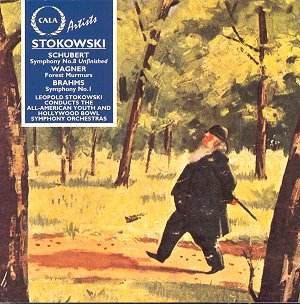This is another well-filled Cala disc with an authoritative
sleeve note by Edward Johnson. It sees Stokowski in a transitional period
conducting two orchestras, both of which he created. The All-American
Youth Orchestras comprised 90 members ranging in age from 14-25 but
with a stiffening of younger musicians from the Philadelphia. The Hollywood
Bowl Symphony Orchestra was commonly thought to comprise members of
the Los Angeles Orchestra but in fact was drawn from top players in
the studio orchestras, many of whom had themselves been symphonic players
or soloists in their own right. When one thinks that the studio orchestras
at around this time had such figures as Toscha Seidel, members of the
Hollywood String Quartet and Warwick Evans, cellist of the London Quartet,
one can gauge the level of talent available.
Stokowski recorded the Schubert Unfinished four times.
His first was an acoustic Philadelphia traversal in 1924 and this 1941
recording was his third. It never replicates the powerful string tone
of the second of his recordings with the Philadelphians from 1927 and
is in any case poorly recorded, with slightly scuffy surfaces that were
apparently taken from the 33 1/3 lacquer originals. I find the performance
over emphatic with phrasing too comfortably self-satisfied. It was the
only Schubert symphony he was to record.
The Brahms First presents other points of interest
and contention. Since he was a prolific recorder and re-recorded much
of his repertoire, sometimes as much as eight times over in the case
of Stravinsky’s The Firebird, we are better able to see the fluctuations
and tempo-relations and other organizational decision making in the
light of his performance history as a whole. This is especially so in
the case of the Brahms First because evidence exists from 1972 that
he could confound expectation and radically rethink interpretation or
be caught up with factors, maybe external ones, which led to reappraisal.
The commercially issued 1972 LSO recording differs markedly from a live
Croydon broadcast with the same orchestra at around the same time. In
the case of the 1941 recording I have ambivalent feelings; I admire
the drama inherent in Stokowski’s conception, the string cantilena in
the slow movement is superbly done, as is the layering of weight and
tone throughout. It is a strong and individual conception powerfully
alive to sectional balance and bass led sonorities. And yet it is also
somewhat wilful with unmarked accelerandos and in the finale especially
a degree of tempo-related manhandling which results, to my ears, in
a fatal haemorrhaging of architectural coherence. The Wagner acts as
a balance between these two symphonic masterpieces – a gutsy performance.
A controversial brace of recordings then but ones never without Stokowskian
interest.
Jonathan Woolf


